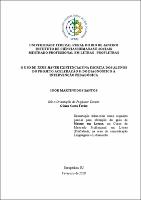Please use this identifier to cite or link to this item:
https://rima.ufrrj.br/jspui/handle/20.500.14407/15451| Tipo do documento: | Dissertação |
| Title: | O uso de ter e haver existenciais na escrita dos alunos do Projeto Aceleração 8: do diagnóstico à intervenção pedagógica |
| Other Titles: | The use of existentials ter and haver in the writing of the students of the Acceleration 8 Project: from the diagnosis to the pedagogical intervention |
| Authors: | Santos, Igor Martins dos |
| Orientador(a): | Freire, Gilson Costa |
| Primeiro membro da banca: | Freire, Gilson Costa |
| Segundo membro da banca: | Lima, Ricardo Joseh |
| Terceiro membro da banca: | Santos, Ângela Marina Bravin dos |
| Keywords: | Produção textual;Variação;Verbos existenciais;Letramento;Textual production;Variation;Existential Verbs;Literacy |
| Área(s) do CNPq: | Educação |
| Idioma: | por |
| Issue Date: | 22-Aug-2018 |
| Publisher: | Universidade Federal Rural do Rio de Janeiro |
| Sigla da instituição: | UFRRJ |
| Departamento: | Instituto de Ciências Humanas e Sociais |
| Programa: | Programa de Pós-Graduação em Letras |
| Citation: | SANTOS, Igor Martins dos. O uso de ter e haver existenciais na escrita dos alunos do Projeto Aceleração 8: do diagnóstico à intervenção pedagógica. 2018. 101 f.. Dissertação(Mestrado em Letras) - Instituto de Ciências Humanas e Sociais, Universidade Federal Rural do Rio de Janeiro,Seropédica-RJ, 2018 . |
| Abstract: | Baseada nas contribuições da Sociolinguística Variacionista ao ensino, em especial a teoria dos contínuos de variação linguística (cf. BORTONI-RICARDO, 2004), esta pesquisa desenvolve uma mediação pedagógica para o trabalho com o uso de <ter> e <haver> existenciais numa turma do Projeto Acelera do Ensino Fundamental, por meio de atividades de produção de textos de diferentes gêneros, distribuídos num contínuo de oralidadeletramento. Dois foram os objetivos traçados: (a) mapear as ocorrências de <ter> e <haver> nos textos dos alunos ao longo da mediação pedagógica, descrevendo o seu comportamento linguístico em cada gênero trabalhado; (b) levar esses mesmos alunos ao emprego consciente das duas variantes nos diferentes gêneros textuais, de acordo com o contínuo de oralidadeletramento. Para compor o contínuo, foram selecionados os seguintes gêneros: HQ (histórias em quadrinhos), memorial e reportagem. De modo geral, os resultados mostram que os alunos conseguiram manifestar o uso das variantes de acordo com o praticado pelo brasileiro letrado em cada ponto do contínuo: nos textos situados no polo de [+ oralidade], houve emprego predominante de <ter>; nos do ponto intermediário, apareceram as duas variantes; nos do polo de [+ letramento], prevaleceu o uso de <haver>, conforme a prescrição das gramáticas normativas para os textos que representam eventos de comunicação mediados pela escrita. Tais resultados, por um lado, corroboram o que as pesquisas sociolinguísticas descrevem sobre o emprego de <ter> e <haver> existenciais no Português Brasileiro (cf. AVELAR, 2006); por outro, revelam como a escolarização é determinante para a aprendizagem de estruturas típicas da variedade de prestígio, como a variante <haver> (cf. VITÓRIO, 2008), requeridas pela sociedade letrada em determinados contextos de uso da língua |
| Abstract: | Based on the contributions of Variationist Sociolinguistics to teaching, in special to the theory of continuums of linguistic variation (BORTONI-RICARDO, 2004), this research develops a pedagogical mediation for the work with the usage of <ter> and <haver> in a class of the Accelerates Project of the Primary Education, through production activities of texts of different genres, distributed in a continuum of orality-literacy. Two were the traced objectives: (a) to map the occurrences of <ter> and <haver> in the students’ texts over the pedagogical mediation, describing their linguistic behavior in each worked genre; (b) to take these same students to the conscious employment of the two variants in the different textual genres, according to the orality-literacy continuum. In order to constitute the continuum, the following written genres were selected: CB (comic books), memorial and reporting. In general, the results show that the students were able to manifest the use of the variants according to the one practiced by the literate Brazilian in each point of the continuum: in texts placed on the pole of [+ orality], there was predominant employment of <ter>, in the ones of the intermediate point, it appeared both variants; in the ones of the pole of [+literacy], the use of <haver> prevailed according to the prescription of normative grammars to the texts that represent communication events mediated by the writing. Such results, on the one hand, corroborate what the sociolinguistic researches describe about the employment of existentials <ter> and <haver> in the Brazilian Portuguese (AVELAR, 2006); on the other hand, they reveal how schooling is decisive for the learning of structures typical to the variety of prestige, like the variant <haver> (VITÒRIO, 2008), required by the literate society in certain contexts of the language’s use |
| URI: | https://rima.ufrrj.br/jspui/handle/20.500.14407/15451 |
| Appears in Collections: | Mestrado Profissional em Letras |
Se for cadastrado no RIMA, poderá receber informações por email.
Se ainda não tem uma conta, cadastre-se aqui!
Files in This Item:
| File | Description | Size | Format | |
|---|---|---|---|---|
| 2018 - Igor Martins dos Santos.pdf | Igor Martins dos Santos | 3.19 MB | Adobe PDF |  View/Open |
Items in DSpace are protected by copyright, with all rights reserved, unless otherwise indicated.

